Social-Aware Link Reliability Prediction Model Based Minimum Delay Routing for CR-VANETs
Abstract
1. Introduction
2. Related Work
2.1. Current Research of Social-Aware Cognitive Ad Hoc Networks Routing
2.2. Current Research of Social-Aware Vehicular Ad Hoc Networks Routing
2.3. Current Research of Cognitive Radio Vehicular Ad Hoc Network
3. Social-Based Link Reliability Prediction Model for CR-VANETs
4. Social-Aware Minimum Delay Routing for CR-VANETs
4.1. Problem Formulation
4.1.1. Delay in Road Sections
4.1.2. Delay at Intersections
- (1)
- The current traffic signal is red.
- ①
- Available channels
- ②
- No available channel
- (2)
- The current traffic signal is green.
- ①
- Available channels
- ②
- No available channels
4.2. Minimum End-to-End Delay Routing Algorithm
4.2.1. Routing Metrics Design
4.2.2. Minimum Delay Routing in Road Segments
| Algorithm 1: SMDR Algorithm |
| Inputs: source vehicle , target vehicle Output: channel set , relay vehicle 1. Define the sets , , , 2. while ! = 3. Channel detection for SU vehicles 4. if all channels are occupied by the PU 5. Store the packet and wait for , is calculated by Equation (15) 6. Channel detection for SU vehicles 7. else 8. Calculate the active probability of the PU on the available channels according to Equation (4), and sort the available channels in the set of channels . 9. Select the channel with the lowest active probability of the PU and add to the set of channels 10. if (! =) 11. Select neighboring vehicles in the same direction of motion as the packet transmission direction to join the forwarding set 12. According to Equation (6), calculate the vehicles in the forwarding set and their similarity value , and get the set of values in the forwarding set . 13. Select the largest vehicle from the set and merge it into the set . 14. 15. else 16. if () Pass the packet 17. else Greedy Forwarding 18. Merge into 19. end if 20. end if 21. end if 22. end while 23. return , |
4.2.3. Minimum Delay Routing in Intersections
| Algorithm 2: SMDI Algorithm |
| Inputs: source vehicle , target vehicle Output: set of selected road intersection sections , set of relay vehicles , set of selected channels 1. Define the sets , , , , , define the variables 2. while ! = /* If all channels are occupied by the PU, carry the packet and wait */ 3. The SU vehicle performs channel detection 4. if all channels are occupied by the PU 5. if (! = && == red &&) 6. Store packets and wait for 7. else 8. Store the packet and wait for , calculated by Equation (14) 9. The SU vehicle performs channel detection 10. end if 11. else /*Channel selection when there are available channels*/ 12. Calculate the active probability of the PU according to Equation (5) and sort the available channels in the set of channels . 13. Select the channel with the lowest active probability of the PU and add to the set of channels. 14. if (! =) 15. Select the smaller two angles and label the corresponding road sections as and from the set of angles at the intersection 16. Calculate the duration of uninterrupted communication on the road sections and and according to Equation (29) 17. if ( > ) 18. Add to , 19. else 20. Add to , 21. end if 22. Select neighboring vehicles to join the forwarding pool in the same direction of motion as packet transmission 23. Calculate the weights of all vehicles in according to Equation (30) and obtain the set of weights . 24. Sort to get the vehicle with the largest value in the set 25. Add to the collection . 26. 27. else 28. if () Pass the packet 29. else Greedy Forwarding 30. Merge into 31. Incorporate into 32. end if 33. end if 34. end if 35. end while 36. return , , |
5. Performance Evaluation
5.1. Simulation Setup and Algorithm Implementation
Simulation Data Processing
5.2. Simulation Results
5.2.1. Performance with Different Numbers of PUs
5.2.2. Performance with Different Numbers of Channels
5.2.3. Performance with Different Numbers of Vehicles
6. Conclusions
Author Contributions
Funding
Data Availability Statement
Conflicts of Interest
References
- Zhao, J.; Gai, X.; Luo, X. Performance comparison of vehicle networking based on DSRC and LTE technology. In International Conference on Intelligent Transportation Engineering; Springer Nature: Singapore, 2021. [Google Scholar]
- Khalek, N.A.; Tashman, D.H.; Hamouda, W. Advances in Machine Learning-Driven Cognitive Radio for Wireless Networks: A Survey. IEEE Commun. Surv. Tutor. 2023, 26, 1201–1237. [Google Scholar] [CrossRef]
- Duan, W.; Tang, X.; Zhou, J.; Wang, J.; Zhou, G. Load balancing opportunistic routing for cognitive radio ad hoc networks. Wirel. Commun. Mob. Comput. 2018, 2018, 9412782. [Google Scholar] [CrossRef]
- Sun, R.; Huang, Y.; Zhu, L. Communication by credence: Trust communication in vehicular Ad Hoc networks. Mob. Netw. Appl. 2022, 27, 510–522. [Google Scholar] [CrossRef]
- Abdelkader, G.; Elgazzar, K.; Khamis, A. Connected vehicles: Technology review, state of the art, challenges and opportunities. Sensors 2021, 21, 7712. [Google Scholar] [CrossRef]
- Jiang, Q.; Tang, X.; Wang, J. QoS-Aware Route Navigation for Pedestrians Using 5G Cellular Networks. In Proceedings of the 2024 IEEE 35th International Symposium on Personal, Indoor and Mobile Radio Communications (PIMRC), Valencia, Spain, 2–5 September 2024; pp. 1–6. [Google Scholar] [CrossRef]
- Pari, D.; Natarajan, J. Secure spectrum access, routing, and hybrid beamforming in an edge-enabled mmwave massive MIMO CRN-based internet of connected vehicle (IoCV) environments. Sensors 2022, 22, 5647. [Google Scholar] [CrossRef]
- Sangi, A.R.; Alkatheiri, M.S.; Anamalamudi, S.; Alqarni, M.A.; Memon, M.H.; Yang, W. Spectrum handoff aware aodv routing protocol for cognitive radio vehicular ad hoc networks. Complexity 2021, 2021, 6981719. [Google Scholar] [CrossRef]
- Srivastava, A.; Prakash, A.; Tripathi, R. QoS aware stochastic relaxation approach in multichannel CR-VANET: A junction-centric geographic routing protocol. J. Ambient. Intell. Humaniz. Comput. 2023, 14, 11103–11121. [Google Scholar] [CrossRef]
- Al-Absi, M.A.; Al-Absi, A.A.; Sain, M.; Lee, H. Moving ad hoc networks—A comparative study. Sustainability 2021, 13, 6187. [Google Scholar] [CrossRef]
- Ali, R.; Liu, R.; Nayyar, A.; Waris, I.; Li, L.; Shah, M.A. Intelligent driver model-based vehicular ad hoc network communication in real-time using 5G new radio wireless networks. IEEE Access 2023, 11, 4956–4971. [Google Scholar] [CrossRef]
- Wang, X.; You, X. Social attributes based information-centric vehicular cloud data delivery framework. IEEE Internet Things J. 2024, 11, 31180–31189. [Google Scholar] [CrossRef]
- Yao, L.; Wang, Y.; Wang, X.; Wu, G. Cooperative caching in vehicular content centric network based on social attributes and mobility. IEEE Trans. Mob. Comput. 2019, 20, 391–402. [Google Scholar] [CrossRef]
- Zhu, Y.; Xu, B.; Shi, X.; Wang, Y. A survey of social-based routing in delay tolerant networks: Positive and negative social effects. IEEE Commun. Surv. Tutor. 2012, 15, 387–401. [Google Scholar] [CrossRef]
- Ishfaq, U.; Khan, H.U.; Iqbal, S. Identifying the influential nodes in complex social networks using centrality-based approach. J. King Saud Univ.-Comput. Inf. Sci. 2022, 34, 9376–9392. [Google Scholar] [CrossRef]
- Jing, T.; Zhou, J.; Liu, H.; Zhang, Z.; Huo, Y. SoRoute: A reliable and effective social-based routing in cognitive radio ad hoc networks. EURASIP J. Wirel. Commun. Netw. 2014, 2014, 200. [Google Scholar] [CrossRef][Green Version]
- Lu, J.; Cai, Z.; Wang, X.; Zhang, L.; Li, P.; He, Z. User social activity-based routing for cognitive radio networks. Pers. Ubiquitous Comput. 2018, 22, 471–487. [Google Scholar] [CrossRef]
- Zhang, L.; Cai, Z.; Li, P.; Wang, L.; Wang, X. Spectrum-availability based routing for cognitive sensor networks. IEEE Access 2017, 5, 4448–4457. [Google Scholar] [CrossRef]
- Yang, J.; Ma, C.; Man, J.; Xu, H.; Zheng, G.; Song, H. Cache-enabled in cooperative cognitive radio networks for transmission performance. Tsinghua Sci. Technol. 2019, 25, 1–11. [Google Scholar] [CrossRef]
- Petrov, T.; Finkelberg, I.; Počta, P.; Buzna, Ľ.; Zarkhin, N.; Gal-Tzur, A.; Toledo, T. An analytical approach to the estimation of vehicular communication reliability for intersection control applications. Veh. Commun. 2024, 45, 100693. [Google Scholar] [CrossRef]
- Gatate, V.; Agarkhed, J. Routing based on spectrum quality and availability in wireless cognitive radio sensor networks. In International Conference on Innovative Computing and Communications: Proceedings of ICICC 2021, Delhi, India, 20–21 February 2021; Springer: Singapore, 2022; Volume 1, pp. 497–508. [Google Scholar]
- Khokhar, R.H.; Md Noor, R.; Ghafoor, K.Z.; Ke, C.H.; Ngadi, M.A. Fuzzy-assisted social-based routing for urban vehicular environments. EURASIP J. Wirel. Commun. Netw. 2011, 2011, 178. [Google Scholar] [CrossRef][Green Version]
- Song, Y.; Li, J.; Li, C.; Wang, F. Social popularity based routing in delay tolerant networks. Int. J. Smart Sens. Intell. Syst. 2016, 9, 1687–1709. [Google Scholar] [CrossRef]
- Le, T.; Kalantarian, H.; Gerla, M. A novel social contact graph-based routing strategy for workload and throughput fairness in delay tolerant networks. Wirel. Commun. Mob. Comput. 2016, 16, 1352–1362. [Google Scholar] [CrossRef]
- Kerrache, C.A.; Lagraa, N.; Benslimane, A.; Calafate, C.T.; Cano, J.C. On the human factor consideration for VANETs security based on social networks. In Proceedings of the 2018 IEEE International Conference on Communications (ICC), Kansas City, MO, USA, 20–24 May 2018; pp. 1–6. [Google Scholar]
- Kerrache, C.A.; Lagraa, N.; Hussain, R.; Ahmed, S.H.; Benslimane, A.; Calafate, C.T.; Vegni, A.M. TACASHI: Trust-aware communication architecture for social internet of vehicles. IEEE Internet Things J. 2018, 6, 5870–5877. [Google Scholar] [CrossRef]
- Tang, X.; Zhou, J.; Xiong, S.; Wang, J.; Zhou, K. Geographic segmented opportunistic routing in cognitive radio ad hoc networks using network coding. IEEE Access 2018, 6, 62766–62783. [Google Scholar] [CrossRef]
- Wang, J.; Zhang, H.; Tang, X.; Hao, S. Social-aware routing for cognitive radio–based vehicular ad hoc networks. Int. J. Distrib. Sens. Netw. 2019, 15, 1550147719866389. [Google Scholar] [CrossRef]
- Priyadharshini, A.; Sundarambal, M. Cognitive radio based vehicular sensor network using optimal tree routing protocol. Wirel. Pers. Commun. 2020, 110, 2237–2252. [Google Scholar] [CrossRef]
- Smida, E.B.; Fantar, S.G.; Youssef, H. Link efficiency and quality of experience aware routing protocol to improve video streaming in urban VANETs. Int. J. Commun. Syst. 2020, 33, e4209. [Google Scholar] [CrossRef]
- Shen, R.; Wang, X.; Xu, Y. Weighted sum-rate maximized power allocation in downlink MIMO-NOMA systems. In Proceedings of the 2019 IEEE 19th International Conference on Communication Technology (ICCT), Xi’an, China, 16–19 October 2019; pp. 679–684. [Google Scholar]
- Wang, J.; Zhang, H.; Tang, X.; Li, Z. Delay-tolerant routing and message scheduling for CR-VANETs. Future Gener. Comput. Syst. 2020, 110, 291–309. [Google Scholar] [CrossRef]
- Wang, J.; Zhang, H.; Hao, S.; Fu, C. An urban expressway forwarding scheme for cognitive Internet of vehicles. Int. J. Distrib. Sens. Netw. 2020, 16, 1550147720912947. [Google Scholar] [CrossRef]
- Lee, S.; Lee, S.H.; Lee, H. Timely directional data delivery to multiple destinations through relay population control in vehicular ad hoc network. Int. J. Distrib. Sens. Netw. 2020, 16, 1550147720907829. [Google Scholar] [CrossRef]
- Veena, R.C.; Dayanand, L.; Brahmananda, S.H.; Sahana, D.S.; Mala, B.M. A cooperative vehicle intelligence for smart transport services. Int. J. Adv. Trends Comput. Sci. Eng. 2020, 9, 195922020. [Google Scholar] [CrossRef]
- Singh, A.K.; Pamula, R. An efficient and intelligent routing strategy for vehicular delay tolerant networks: An efficient routing strategy for VDTN. Wirel. Netw. 2021, 27, 383–400. [Google Scholar] [CrossRef]
- Awe, O.P.; Babatunde, D.A.; Lambotharan, S.; AsSadhan, B. Second order Kalman filtering channel estimation and machine learning methods for spectrum sensing in cognitive radio networks. Wirel. Netw. 2021, 27, 3273–3286. [Google Scholar] [CrossRef]
- Reddy, C.S.; Subramanyam, M.V.; Reddy, P.R. Hybrid strategy for reliable packet transfer and packet loss reduction in cognitive radio Ad-Hoc Network. Int. J. Adv. Technol. Eng. Explor. 2021, 8, 1524. [Google Scholar] [CrossRef]
- Zhang, Z.; Sun, S.; Liu, M.; Li, Z.; Zhang, Q. Rendezvous Delay-Aware Multi-Hop Routing Protocol for Cognitive Radio Networks. In Proceedings of the 2022 18th International Conference on Mobility, Sensing and Networking (MSN), Guangzhou, China, 14–16 December 2022; pp. 28–35. [Google Scholar]
- Chen, G.; Zhu, H.; Xu, Y.; Song, T.; Hu, J. A Novel Joint Spectrum Sensing and Resource Allocation Scheme in Cognitive Internet of Vehicles Networks. IEEE Trans. Veh. Technol. 2024, 73, 13412–13424. [Google Scholar] [CrossRef]
- Patel, D.K.; Kavaiya, S.; Ding, Z.; Guan, Y.L.; Sun, S. Impact of primary user activity statistics in cognitive vehicular networks. IEEE Trans. Veh. Technol. 2021, 71, 2859–2873. [Google Scholar] [CrossRef]
- Wang, J.; Mei, A.; Tang, X.; Shi, B. Social-Based Link Reliability Prediction Model for CR-VANETs. In Wireless Algorithms, Systems, and Applications: 16th International Conference, WASA 2021, Nanjing, China, 25–27 June 2021; Proceedings, Part I 16; Springer: Cham, Switzerland, 2021; pp. 376–388. [Google Scholar]
- McNett, M.; Voelker, G.M. Access and mobility of wireless PDA users. ACM SIGMOBILE Mob. Comput. Commun. Rev. 2005, 9, 40–55. [Google Scholar] [CrossRef]
- Granovetter, M. The strength of weak ties: A network theory revisited. Sociological theory 1983, 1, 201–233. [Google Scholar] [CrossRef]
- Shiang, H.P.; Van der Schaar, M. Distributed resource management in multihop cognitive radio networks for delay-sensitive transmission. IEEE Trans. Veh. Technol. 2008, 58, 941–953. [Google Scholar] [CrossRef]
- Li, G.; Boukhatem, L. An intersection-based delay sensitive routing for VANETs using ACO algorithm. In Proceedings of the 2014 23rd International Conference on Computer Communication and Networks (ICCCN), Shanghai, China, 4–7 August 2014; pp. 1–8. [Google Scholar]
- Caviglia, R.; Gaggero, G.; Portomauro, G.; Patrone, F.; Marchese, M. An SDRBased Cybersecurity Verification Framework for Smart Agricultural Machines. IEEE Access 2023, 11, 54210–54220. [Google Scholar] [CrossRef]
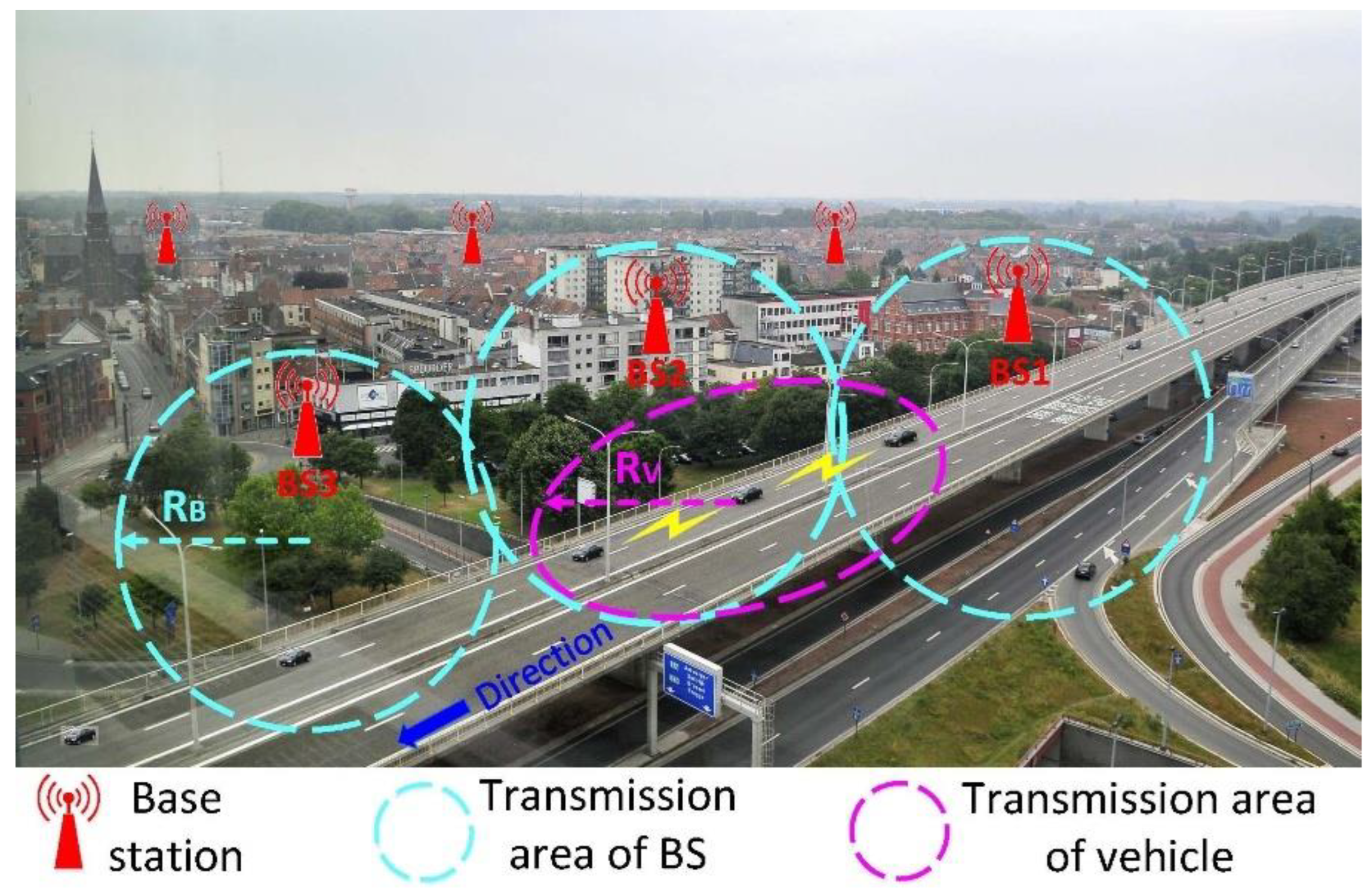

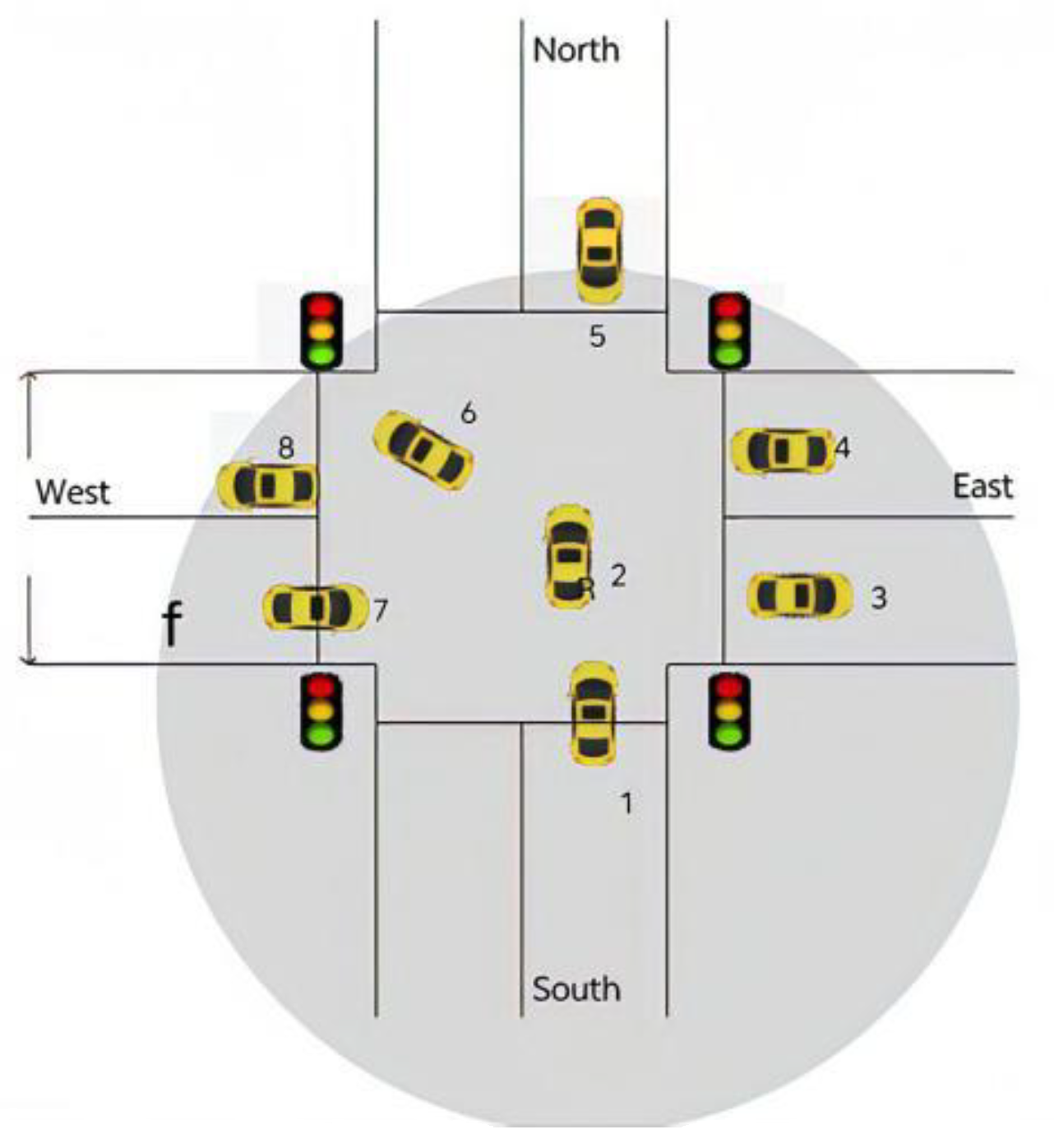
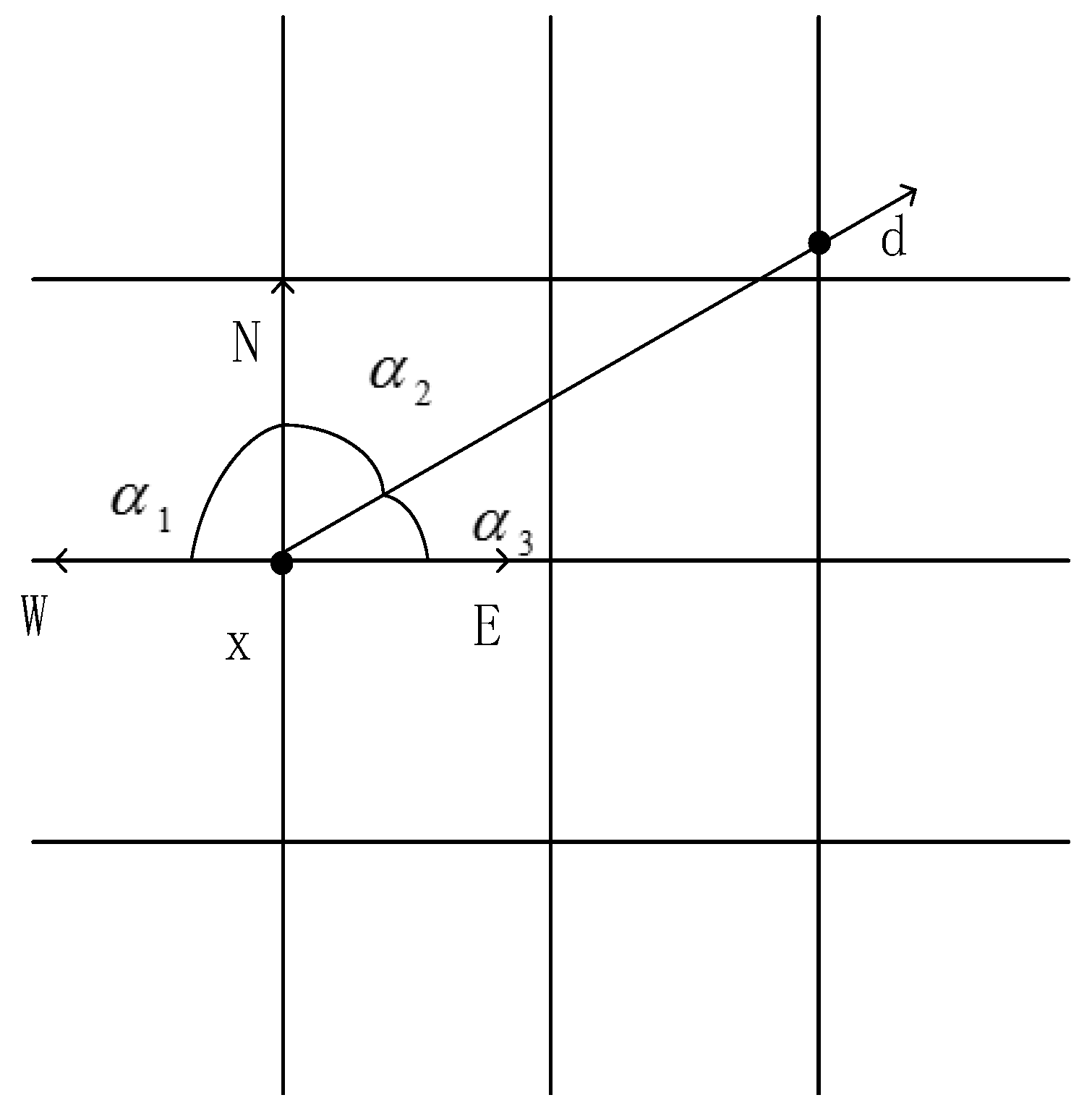

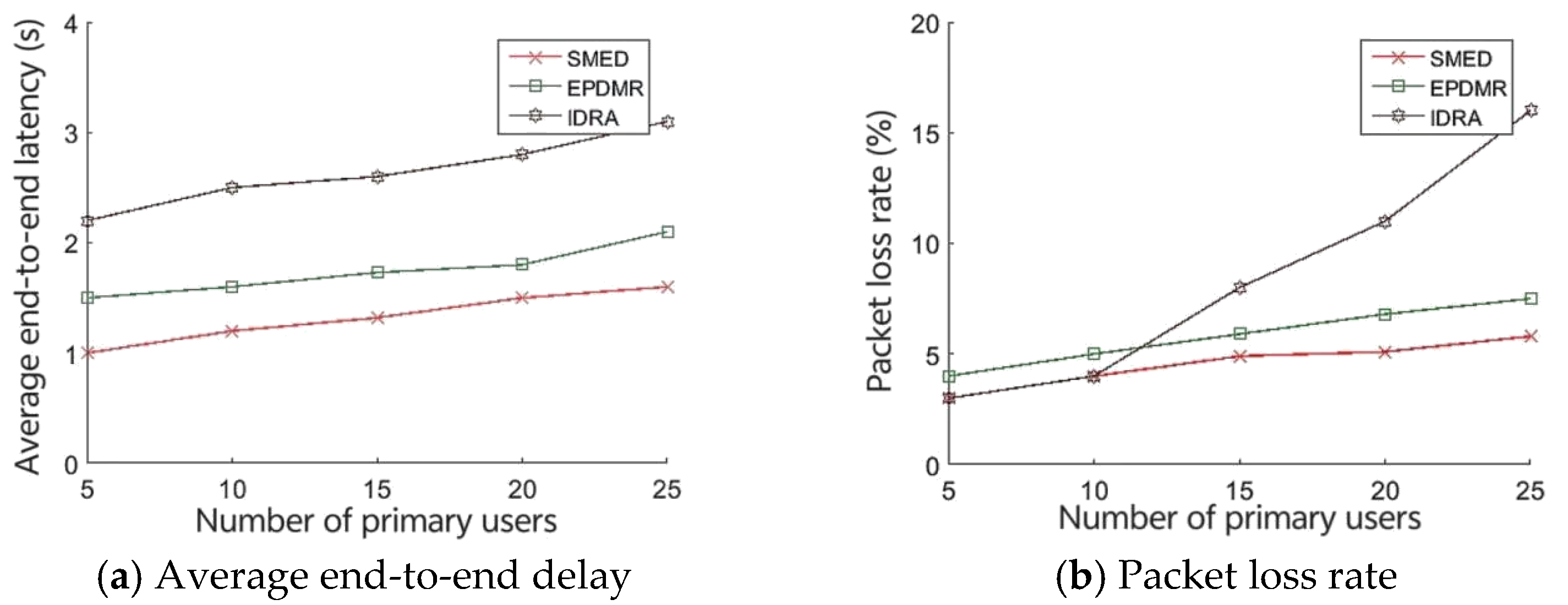
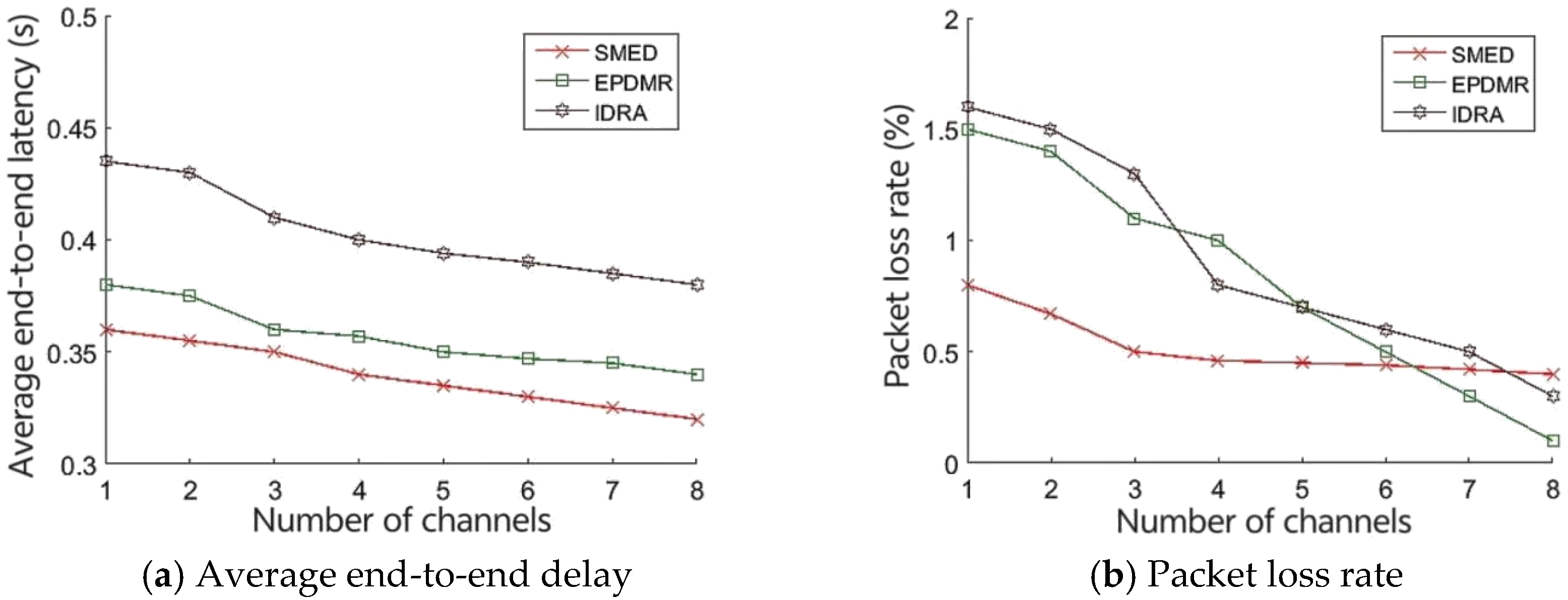
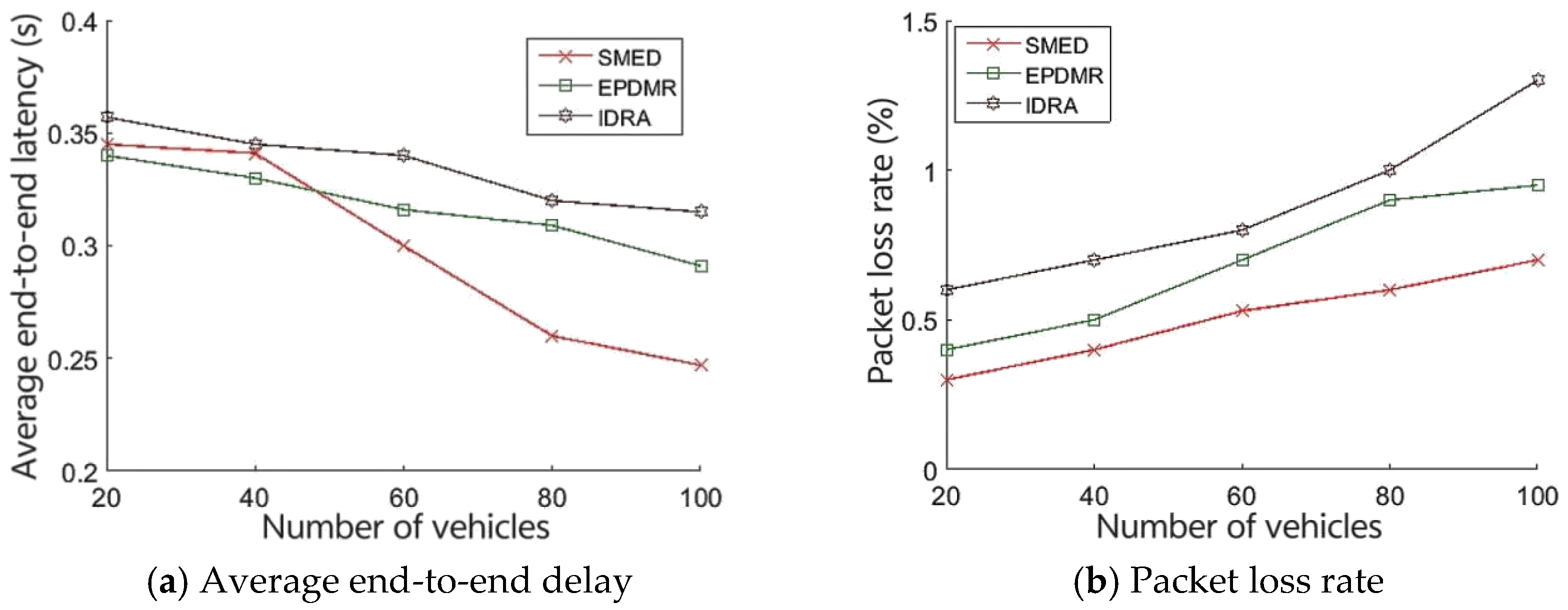
| Symbol | Meaning | Symbol | Meaning |
|---|---|---|---|
| G | Number of parallel roads | O | Number of road intersections |
| H | Number of road segments | e | Length of road segments |
| f | Width of the road | μ | Expectation of the normal distribution |
| σ | Variance of the normal distribution | f(x) | Probability density function |
| F(x) | Cumulative density function | p(t1, t2) | Probability that the primary user is active from t1 to t2 |
| p′(t) | Probability that the primary user is active in the t-th time slot | q(t1, t2) | Probability that there is no available channel from t1 to t2 |
| fᵢⱼ | Frequency of encounters between vehicle i and vehicle j | tᵢⱼ | Encounter time between vehicle i and vehicle j |
| sim(Vᵢ, Vⱼ) | Similarity between vehicle i and vehicle j | d(i) | Degree centrality of vehicle i |
| V | Set of all vehicle nodes | Fₗᵢ | Set of friends of vehicle i |
| K | Number of friend vehicles of vehicle i | D | Number of neighbor vehicle nodes of vehicle i |
| ε | Weight of a friend link | α | Weight of a normal link |
| lᵢⱼ | Link between vehicle i and vehicle j | bc(j) | Betweenness centrality of vehicle j |
| ωⱼₖ | Number of shortest paths from vehicle j to vehicle k | sⁿ | Base number of vehicles |
| N | Number of primary users | M | Number of secondary users |
| C | Total number of channels | cᵢ | The i-th channel |
| Ψ | Set of all channels | Pᵢ | The i-th primary user |
| Vᵢ | The i-th secondary user vehicle | Sᵢ | The i-th base station |
| Rₚ | Primary user transmission radius | ρᵥ | Secondary user transmission radius |
| θᵢⱼ | Availability of the link from vehicle i to vehicle j | dᵢⱼ | Euclidean distance between vehicle i and vehicle j |
| Nᵢ | Set of neighbor nodes of vehicle i | T_busy | Time the primary user occupies the channel |
| d_density | Density of vehicles | T | Total number of time slots |
| T_idle | Time the primary user does not occupy the channel | eᵢ | Edge between vehicle i and vehicle j |
| rᵢⱼ(t) | Probability that the link between vehicle i and vehicle j is not interrupted at time t | Yᵢⱼ(t) | Probability that the link between vehicle i and vehicle j does not suffer physical interruptions at time t |
| Iᵖᵏ | Probability that the primary user does not interfere at time k | Iᵗᵢ(t) | Probability that no cognitive interference occurs in the t-th time slot |
| pᵥ(t1, t2) | Probability that the link remains stable from t1 to t2 | E_error | Error rate in primary user activity prediction |
| m(i) | Secondary user attribute measure | E′_error | Error rate in link stability prediction |
| Eₚ | Actual value of link stability prediction | Eₑ | Predicted value of link stability |
| ETT | Transmission time per hop on a link | dᵢ | Waiting time for an available channel |
| r | Packet transmission rate | p | Packet error rate per channel |
| rᵢⱼ(t) | Probability of link stability between vehicle i and vehicle j | E | Expected delay in the road segment |
| Tct_w | Waiting time for an available channel | tᵢ | Time the hop starts |
| Tᵣ_hop | Delay of one hop in a road segment | hᵩ | Number of hops in a road segment |
| E(Tᵣ_road) | Expected delay in a road segment | dᵣ | Number of road segments |
| Tᵣ_road | Expected delay in a road segment | Tᵣ_red | Remaining red light time at the current moment |
| E(Tᵣ_road) | Expected delay in a road segment | χ | Vehicle speed |
| Vₛ | Vehicle weight | V_d | Target vehicle |
| C_list | Set of road segments selected from source vehicle to target vehicle | Φ | Set of road intersection segments selected for routing |
| W | Set of angles between the road segment and target vehicle |
| Parameters | Retrieve a Value |
|---|---|
| Number of PUs | [5, 25] |
| Number of SUs | [20, 100] |
| vehicle speed | 50 km/h |
| Number of channels | [1, 8] |
| PUs’ arrival rate | 0.5/s |
| Channel time occupied by PUs | 0.3 s |
| Number of roads | 5 |
| Road length | 2 km |
| Red light time | 60 s |
| Green light time | 60 s |
| Vehicle transfer radius | 200 m |
| PUs’ interference radius | 250 m |
| MAC layer protocol | 802.11p |
Disclaimer/Publisher’s Note: The statements, opinions and data contained in all publications are solely those of the individual author(s) and contributor(s) and not of MDPI and/or the editor(s). MDPI and/or the editor(s) disclaim responsibility for any injury to people or property resulting from any ideas, methods, instructions or products referred to in the content. |
© 2025 by the authors. Licensee MDPI, Basel, Switzerland. This article is an open access article distributed under the terms and conditions of the Creative Commons Attribution (CC BY) license (https://creativecommons.org/licenses/by/4.0/).
Share and Cite
Wang, J.; Dan, W.; Li, H.; Yan, L.; Mei, A.; Tang, X. Social-Aware Link Reliability Prediction Model Based Minimum Delay Routing for CR-VANETs. Electronics 2025, 14, 627. https://doi.org/10.3390/electronics14030627
Wang J, Dan W, Li H, Yan L, Mei A, Tang X. Social-Aware Link Reliability Prediction Model Based Minimum Delay Routing for CR-VANETs. Electronics. 2025; 14(3):627. https://doi.org/10.3390/electronics14030627
Chicago/Turabian StyleWang, Jing, Wenshi Dan, Hong Li, Lingyu Yan, Aoxue Mei, and Xing Tang. 2025. "Social-Aware Link Reliability Prediction Model Based Minimum Delay Routing for CR-VANETs" Electronics 14, no. 3: 627. https://doi.org/10.3390/electronics14030627
APA StyleWang, J., Dan, W., Li, H., Yan, L., Mei, A., & Tang, X. (2025). Social-Aware Link Reliability Prediction Model Based Minimum Delay Routing for CR-VANETs. Electronics, 14(3), 627. https://doi.org/10.3390/electronics14030627







